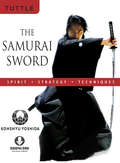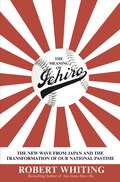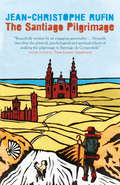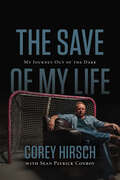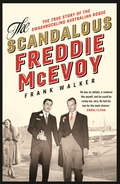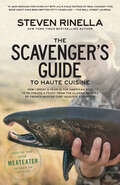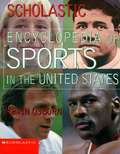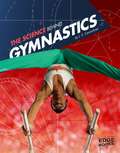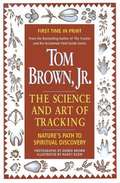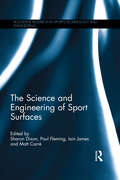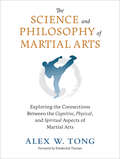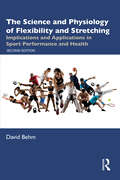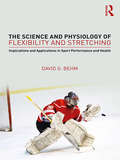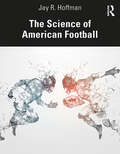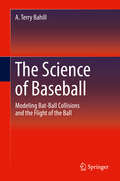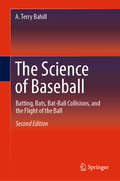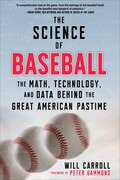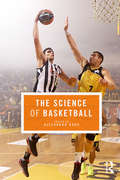- Table View
- List View
The Samurai Sword: Spirit * Strategy * Techniques
by Kohshyu YoshidaThe Samurai Sword is an indispensable guide to theory and practice that respects both the physical and spiritual aspects of martial arts practice with the samurai sword. Featuring guidance for selecting, maintaining and using your sword, it also delves into the practical value of meditation and provides brief, inspirational biographies of some of the greatest samurai, men whose words and deeds embodied the true spirit of the samurai warrior.Written by a descendant of samurai warriors, The Samurai Sword provides both a strong, hands-on foundation for beginners and advice for the practiced swordsperson.
The Samurai Sword: Spirit * Strategy * Techniques
by Kohshyu YoshidaThe Samurai Sword is an indispensable guide to theory and practice that respects both the physical and spiritual aspects of martial arts practice with the samurai sword. Featuring guidance for selecting, maintaining and using your sword, it also delves into the practical value of meditation and provides brief, inspirational biographies of some of the greatest samurai, men whose words and deeds embodied the true spirit of the samurai warrior.Written by a descendant of samurai warriors, The Samurai Sword provides both a strong, hands-on foundation for beginners and advice for the practiced swordsperson.
The Samurai Way of Baseball: The Impact of Ichiro and the New Wave from Japan
by Robert WhitingMatsui... Nomo... Sasaki... Ichiro... the so-called American "National Pastime" has developed a decidedly Japanese flair. Indeed, in this year's All-Star game, two of the starting American League outfielders were from Japan. And for the third straight year, Ichiro - the fleet-footed Seattle Mariner - received more votes for the All-Star game than any other player in the game today. Some 15 years ago, in the bestseller "You Gotta Have Wa," Robert Whiting examined how former American major league ballplayers tried to cope with a different culture while playing pro ball in Japan. Now, Whiting reverses his field and reveals how select Japanese stars have come across the Pacific to play in the big leagues. Not only have they had to deal with the American way of life, but they have individually changed the game in dramatic fashion.
The Santa Season
by Linda Ford[from the back cover] "To get home safe Nick and Marcia need a grand slam of a plan. Ever since Nick and Marcia found out that their grandfather is Santa Claus, their lives have been anything but ho-hum. So, when Nick brings home a strange contraption from the North Pole workshop, he should know it will be trouble. With one accidental pull of a lever, Nick and Marcia hurtle back through time. They find out that things are different in the 1800s, but even though there isn't indoor plumbing, there is still baseball... and Santa. If only there were an easy way home." All of Nick and Marcia's funny and exciting adventures as Santa's grandchildren are in the other four books in this series and you'll find them in the Bookshare library. They are: Santa Claus, Inc., Santa S.O.S., The Santa Solution and The Santa Contest
The Santa Suit (Holiday Homecoming)
by Karen Toller WhittenburgHOLIDAY HOMECOMINGThe man in the red suit...had a lot to answer for, in Kate Harmon's opinion! He'd let her down and now her twins' heads were filled-not with visions of sugarplums but kittens, dogs and a daddy!It'd be a cold midnight clear before that Christmas fancy came true, 'cause Kate didn't date-and Santa didn't exist.So why had the twins hired Gabe Housley to find him? And why did Kate hope Gabe-the man who'd kissed her and dismissed her last Christmas-was Santa's answer to the twins' wish list?
The Santiago Pilgrimage: Walking the Immortal Way
by Jean-Christophe Rufin"Whenever I was asked: 'Why did you go to Santiago?', I had a hard time answering. How could I explain to those who had not done it that the way has the effect - if not the virtue - to make you forget all reasons that led you to become involved in it in the first place."Each year, tens of thousands of backpackers (Christian pilgrims and many others) set out from either their front doorstep or from popular starting points across Europe, to Santiago de Compostela. Most travel by foot, others ride a bicycle, and a few of them travel as did some of their medieval counterparts, on horseback or with a donkey. In addition to those who undertake a religious pilgrimage, the majority are hikers who walk the way for non-religious reasons: travel, sport, or simply the challenge of spending weeks walking in a foreign land. Also, many consider the experience as a spiritual adventure, with a view to removing themselves from the bustle of modern life. Jean-Christophe Rufin followed this "Northern Way" to Santiago de Compostela by foot, on over eight hundred kilometers. Much less crowded than the usual pilgrimage route, this one runs along the Basque and Cantabrian coasts in Spain and through the wild mountains of Asturias and Galicia.Translated from the French by Malcolm Imrie and Martina Dervis
The Save of My Life: My Journey Out of the Dark
by Corey Hirsch Sean Patrick ConboyA riveting look behind the mask of an NHL goalie, The Save of My Life offers understanding and hope to anyone living with mental illnessBy the time he was twenty-two years old, goaltender Corey Hirsch had realized his childhood dream of playing in the NHL, won an Olympic medal and drunk from the Stanley Cup. While he excelled on the ice, out of the net Hirsch was plagued by persistent dark thoughts and ceaseless anxiety. On days when he could barely get out of bed, he was able to push aside the endless loop of dark thoughts running inside his brain long enough to win a game. But as soon as he got back home, the agonizing cycle started all over again. And it continued, until finally he was able to confide in a team trainer who helped him get the professional treatment he needed. Diagnosed with obsessive-compulsive disorder, Hirsch was able to embark on the rocky road to recovery. As one of the first professional athletes to talk openly about mental health, Hirsch wrote about his OCD for the Players’ Tribune. His piece remains one of their most-read articles ever.As Hirsch says, “I am not insane. I am not a bad person. I am not weak. I have an illness, and there is a treatment.”
The Scandalous Freddie McEvoy: The true story of the swashbuckling Australian rogue
by Frank WalkerSwashbuckler, daredevil racing-car champion, Winter Olympian, gambler, smuggler, scoundrel, stud and suspected Nazi agent who died a mysterious death - this is the fascinating story of the scandalous Freddie McEvoy.Born in Melbourne in 1907, Freddie's life took him from socialising with a young Errol Flynn in Sydney and on to the French Riviera in the heady years leading up to World War II. With his dashing good looks and charm, Freddie lived a swashbuckling life, quickly figuring out his path to easy fortune was through lonely rich women. World War II didn't stop Freddie's hedonistic pursuits - he skipped enlistment for Australia and Britain to party on in Hollywood, where he renewed his friendship with the now infamous Errol Flynn. Always short of cash, Freddie smuggled guns and diamonds on his yacht between California and Mexico and was rumoured to have worked as a spy. It was a life lived large and Freddie's death in 1951 was under the most mysterious circumstances off the coast of Morocco: his body was found naked and scalped . . .Frank Walker, bestselling author of The Tiger Man of Vietnam and Maralinga, has for the first time uncovered the complete, outrageous and incredible true story of Freddie McEvoy, Australia's daredevil lothario.'Freddie was one of the great livers of life. He lived it the way he saw it - he didn't give a hoot.'Errol Flynn'Pleasure is my business.' Freddie McEvoy'an extraordinary yarn . . . finely researched' Sun-Herald on Frank Walker's Ghost Platoon
The Scavenger's Guide to Haute Cuisine: How I Spent a Year in the American Wild to Re-create a Feast from the Classic Recipes of French Master Chef Auguste Escoffier
by Steven RinellaWhen outdoorsman, avid hunter, and nature writer Steven Rinella stumbles upon Auguste Escoffier's 1903 milestone Le Guide Culinaire, he's inspired to assemble an unusual feast: a forty-five-course meal born entirely of Escoffier's esoteric wild game recipes. Over the course of one unforgettable year, he steadily procures his ingredients--fishing for stingrays in Florida, hunting mountain goats in Alaska, flying to Michigan to obtain a fifteen-pound snapping turtle--and encountering one colorful character after another. And as he introduces his vegetarian girlfriend to a huntsman's lifestyle, Rinella must also come to terms with the loss of his lifelong mentor--his father. An absorbing account of one man's relationship with family, friends, food, and the natural world, The Scavenger's Guide to Haute Cuisine is a rollicking tale of the American wild and its spoils. Praise for The Scavenger's Guide to Haute Cuisine "If Jack Kerouac had hung out with Julia Child instead of Neal Cassady, this book might have been written fifty years ago. . . . Steven Rinella brings bohemian flair and flashes of poetic sensibility to his picaresque tale of a man, a cookbook, and the culinary open road."--The Wall Street Journal "If you rue the 'depersonalization of food production,' or you're tired of chemical ingredients, [Rinella] will make you howl."--Los Angeles Times "A walk on the wild side of hunting and gathering, sure to repel a few professional food sissies but attract many more with its sheer in-your-face energy and fine storytelling."--Jim Harrison, author of Legends of the Fall "[A] warped, wonderful memoir of cooking and eating . . . [Rinella] recounts these madcap wilderness adventures with delicious verve and charm."--Men's JournalFrom the Trade Paperback edition.
The Scholastic Encyclopedia of Sports in the United States
by Kevin OsbornThis volume explores the fascinating history of American sports, from being the Devil's pastime in Puritan New England to the celebrity-filled big business it is today. Readers will learn about many stars as well as less famous athletes, and the personal attributes of players that make them outstanding and influential people.
The School of Fencing: With a General Explanation of the Principal Attitudes and Positions Peculiar to the Art
by Domenico AngeloDomenico Angelo's book, complete with diagrams, embodies the ideas of an era. Philip Stafford in The Times Literary Supplement This is a fascinating read and surprisingly up to date. Every fencer will learn from it . . . Very highly recommended. The Sword. If there is one book on smallsword technique that a person should have in their collection, Angelos treatise is certainly that book. JL Forgeng in Man At Arms magazine. Domenico Angelos The School of Fencing was first published in 1763 as LEcole des armes and was one of the most popular and influential treatises of its time. Today, it remains essential reading for any historical swordfighter, student of martial arts, or military historians, giving the reader access to one of the great masters of the art. This modern edition is annotated by Maestro Jeannette Acosta-Martinez, who is currently the foremost expert in the French small sword. Her additions to this edition help clarify Angelos text for the modern reader. This edition also includes an Introduction by the editor, Jared Kirby, which gives a short history of Angelos life.
The School of Fencing: With a General Explanation of the Principal Attitudes and Positions Peculiar to the Art
by Domenico AngeloDomenico Angelo's book, complete with diagrams, embodies the ideas of an era. Philip Stafford in The Times Literary Supplement This is a fascinating read and surprisingly up to date. Every fencer will learn from it . . . Very highly recommended. The Sword. If there is one book on smallsword technique that a person should have in their collection, Angelos treatise is certainly that book. JL Forgeng in Man At Arms magazine. Domenico Angelos The School of Fencing was first published in 1763 as LEcole des armes and was one of the most popular and influential treatises of its time. Today, it remains essential reading for any historical swordfighter, student of martial arts, or military historians, giving the reader access to one of the great masters of the art. This modern edition is annotated by Maestro Jeannette Acosta-Martinez, who is currently the foremost expert in the French small sword. Her additions to this edition help clarify Angelos text for the modern reader. This edition also includes an Introduction by the editor, Jared Kirby, which gives a short history of Angelos life.
The Science Behind Gymnastics (Science Of The Summer Olympics Ser.)
by L. E. CarmichaelBehind every jump, spin, and flip of Olympic gymnastics, science is at work. Centripetal force is at work in a spin around a bar, and center of gravity is involved in balance beam routines. Newton’s Third Law of Motion springs into action as a gymnast flies into the air in the vaulting event. Find out how science is involved in all your favorite gymnastics events and how gymnasts take science into account in their quest for the gold medal.
The Science and Art of Tracking
by Tom BrownTom Brown was taught the ancient skills of survival by a Native American he called Grandfather. His most advanced lessons were those of the scouts, members of a secret society who were highly attuned to nature. The scouts refined tracking to a disciplined science and art form. With these physical skills came enhanced perception and true enlightment.
The Science and Engineering of Sport Surfaces (Routledge Research in Sports Technology and Engineering)
by Paul Fleming Sharon Dixon Iain James Matt CarréSports surface design is crucial for the successful performance of sports skills and the reduction of injury risk. Surfaces have developed from natural materials such as turf, clay and cinder, to synthetic surfaces such as acrylic tennis courts, artificial turf for soccer and synthetic running tracks, while our understanding of natural turf has developed in terms of properties appropriate for different sports and surface sustainability. This book draws together the very latest research on biomechanical, medical and engineering approaches to the study of sports surfaces. Written by a team of leading international sport scientists, engineers and technologists, the book covers every key aspect of surface development and design, including: surface behaviour surface classification, function, construction and maintenance influence of surfaces on player performance and injury surface test methods and monitoring development of natural turf and synthetic surfaces shoe-turf interaction future developments in sports surface technology. Representing the most comprehensive and up-to-date study of sports surfaces, this book is important reading for all researchers and professionals working in sports technology, sports engineering, biomechanics or sports medicine.
The Science and Philosophy of Martial Arts: Exploring the Connections Between the Cognitive, Physical, and Spiritual Aspects of Martial Arts
by Alex W. TongThrough the lenses of Shotokan Karate and biomedicine, sensei and biomedical scientist Alex W. Tong shows readers how body, mind, and spirit can be developed through martial arts practice.Through the practice of martial arts, a person can realize their full potential--not only in body, but in mind and spirit. The Science and Philosophy of Martial Arts shows readers how. Author, sensei, and biomedical scientist Alex W. Tong delves into the physical, mental, and spiritual components of martial arts and integrates contemporary sports psychology, kinesiology, and neuroscience into a nuanced and illuminating understanding of what martial arts practice can be. Structured into three sections, Tong discusses: • The Mind: The dao of martial arts, mental tranquility, contemporary neuroscience, and warming up the brain • The Body: Posture and stance, breathing in martial arts, and the physics of mastery and effort • The Spirit: Soul, spirit, and moving zen; nature and manifestations of the spirit Each section includes observations on martial arts origins, physiology, and tangible results on martial arts training. Blending traditional and contemporary approaches, knowledge, and research, The Science and Philosophy of Martial Arts builds a vision of practice that elevates physical performance, awareness, decisiveness, and strength of spirit.
The Science and Physiology of Flexibility and Stretching: Implications and Applications in Sport Performance and Health
by David BehmThe Science and Physiology of Flexibility and Stretching is the most up-to-date and comprehensive book to cover the underlying physiology and psychology of flexibility enhancing techniques, critically assessing why, when, and how we should stretch, as well as offering a highly illustrated, practical guide to stretching exercises. This fully revised new edition not only updates the present information but adds new chapters on areas that have attracted substantial interest in the last 5 years such as foam rolling, vibration, global effects of stretching, alternative methods to increase flexibility (e.g., resistance training) and others.Richly illustrated, and including an online resource, The Science and Physiology of Flexibility and Stretching provides an important scientific inquiry into stretching as well as other flexibility enhancing techniques (e.g., foam rolling, vibration, resistance training, and others) and an invaluable reference for any strength and conditioning coach or student, personal trainer, sports coach, or exercise scientist.
The Science and Physiology of Flexibility and Stretching: Implications and Applications in Sport Performance and Health
by David G. BehmStretching is a fundamentally important part of sport and exercise, playing a role in improving performance, and preventing injury and rehabilitation, but its scientific underpinnings have, to this point, been overlooked in book publishing. The Science and Physiology of Flexibility and Stretching is the most up-to-date and comprehensive book to cover the underlying physiology and psychology of stretching, critically assessing why, when, and how we should stretch, as well as offering a highly illustrated, practical guide to stretching exercises. Placing stretching in the context of both health and performance, the first section of the book sets out the science behind stretching, critically assessing the benefits, disadvantages, and roles of different types of stretching, exploring the mechanisms behind increasing range-of-movement through stretching and other methods, and offering evidence-based guidance on building stretching into warm-ups. In its second section, the book provides a step-by-step guide to static, dynamic, and PRF stretching exercises for beginners, through recreational athletes, to elite performers. Richly illustrated, and including an online resource, The Science and Physiology of Flexibility and Stretching provides an important scientific enquiry into stretching, and an invaluable reference for any strength and conditioning coach or student, personal trainer, sports coach, or exercise scientist.
The Science and Practice of Middle and Long Distance Running
by Richard C. Blagrove; Philip R. HayesThe popularity of distance running as a sport, and a recreational activity, is at an all-time high. Motivated by the desire to achieve a personal best, remain healthy, or simply complete an event, distance runners of all ages and abilities actively seek out advice from experienced coaches and sport scientists. This is also reflected in the growth of programmes of education for young coaches and aspiring sport scientists in recent years. There are a multitude of different approaches to training distance runners; however, the basic principles and ingredients required for success are applicable to any distance runner. The science that underpins the training and physical preparation of distance runners has developed considerably in recent years. The most experienced and successful coaches in the distance running community rarely have the opportunity to share their tried and tested methods of training. Similarly, the novel work of sport scientists is often only accessible to elite runners, their support teams and academia. The Science and Practice of Middle and Long Distance Running links together the science and coaching artistry associated with preparing distance runners for events ranging from 800 m up to ultra-marathon distances. It combines the latest scientific evidence, published by world-leading sport scientists, with the sound training principles and strategies adopted by experienced coaches. The book translates cutting-edge scientific research from the fields of physiology, biomechanics, psychology and nutrition into practical suggestions for achieving success. Important topical issues and contemporary practices related to health and performance are also addressed. This book is an essential addition to the library of any distance runner, coach or sport scientist.
The Science of Alpine Ski Racing
by Jim Taylor James PritchardAlpine skiing or downhill skiing is defined by six disciplines: Downhill, Super G, Giant Slalom, Slalom, Parallel, and Combined that test the athletes’ technical abilities and speed. It has long been a popular sport with many national and international championships and is a mainstay of the Winter Olympic Games. The Science of Alpine Ski Racing is the first book to discuss the science, coaching, research, and training of elite to recreational alpine ski racers for optimal performance. This book brings together the complex physiological, biomechanical, and technical components of the sport in a practical manner with which coaches and researchers alike can adopt to elicit better performance outcomes for athletes. Literature of this kind has never been formally researched and published specifically for the sport of alpine ski racing making it both unique and a cornerstone to the discipline. Backed by cutting-edge research, the book provides practical guidance on preparing athletes for high performance and understanding the core tenets of sports science underpinning it striking a balance between the complex theoretical and practical components coaches and athletes must prepare for in alpine ski racing. Accessibly written and featuring contributions from world-leading experts, The Science of Alpine Ski Racing covers key topics of health, training, and high performance in the sport and will be vital reading for youth coaches, professional ski instructors, strength and conditioning coaches, and sports science staff associated with winter sports programs as well as applied researchers looking for a model to apply to other sports. James (Jimmy) Pritchard is a human performance specialist/sports scientist who has trained and consulted athletes at the Olympic, NHL, NFL, and Division I collegiate level. Specific to alpine ski racing, he served as the Director of Strength and Conditioning for Ski and Snowboard Club Vail in Vail, Colorado where he helped prepare a long list of US Ski Team athletes including Alice McKennis, Mikaela Shiffrin, and Tess Johnson. He is a certified strength and conditioning specialist (CSCS) as well as registered strength and conditioning coach (RSCC) through the NSCA working with athletes and human performance program managers on a regular basis to find optimal human performance solutions. James has presented at conferences around the United States discussing long term athlete development, written over 150 articles for several media outlets, has been published in the NSCA’s Strength and Conditioning Journal, and taught courses about strength and conditioning at Colorado Mountain College. James holds a BSc in Exercise Science from Colorado Mesa University and MSc degree in Exercise Science from Edith Cowan University. Jim Taylor, PhD, Psychology, is an internationally recognized authority on the psychology of sport and parenting. He has consulted with athletes, coaches, and parents in tennis, skiing, cycling, triathlon, track and field, swimming, football, golf, baseball, fencing, and many other sports for more than 30 years. Dr. Taylor is the author of 17 books and the editor of 4 textbooks on sport psychology. He is also a former world-ranked alpine ski racer, second-degree black belt in karate, marathon runner, and Ironman triathlete.
The Science of American Football
by Jay R. HoffmanThe game of American football may be the greatest team sport that exists. It epitomizes the need of a "team" first approach to achieve the desired success. Success is often measured as the hoisting of a championship trophy, which involved a journey that required discipline, perseverance, sacrifice, and hard work. These traits are the backbone of success in football, but more importantly they are the backbone or blueprint for success in life. The Science of American Football provides an in-depth discussion on the physiology of the game of American football, including the physiological strain associated with playing in various environmental extremes. Acclimatization, preparation, and medical issues associated with each of these environmental extremes are discussed as well as medical issues occurring during the athlete’s playing career (common sites of injury) and potential risks arising post-career (e.g. neurological dysfunction, arthritic joints, obesity). The book goes on to consider aspects of player selection and preparation, including discussion of evidence-based physical conditioning programs, appropriate nutrition, and specific dietary supplementation for the American football player. The Science of American Football is the first book to focus on the physiology, science, and medical issues associated with the game of American football and will be key reading for students of coaching and exercise science as well as those with a keen interest in understanding the science of American football, such as coaches and players.
The Science of Baseball
by A. Terry BahillThis book describes the dynamic collisions between baseballs, softballs, and bats, and the intricate modeling of these interactions, using only Newton’s basic principles and the conservation laws of physics. Veteran baseball science author Terry Bahill explains models for the speed and spin of balls and bats and equations for bat-ball collisions at a level accessible to high school and undergraduate physics students, engineering students, and, most importantly, students of the science of baseball. Unlike other, more technical accounts of these phenomena that exhibit similar rigor, the models presented in this volume use only basic physical principles to describe simple collision configurations. Elucidating the most important factors for understanding bat performance—bat weight, moment of inertia, the coefficient of restitution, and characteristics of humans swinging the bats, Dr. Bahill also explains physical aspects of the ideal bat and the sweet spot.• Explains how to select or design an optimal baseball or softball bat and create models for bat-ball collisions using only fundamental principles of mechanics from high school physics;• Describes the results of the collision between baseball and bat using basic mathematics such as equations for the speed of the ball after the collision, bat speed after the collision, and bat rotation after the collision;•Accessible to high school and undergraduate students as well as non-technical aficionados of the science of baseball. “Dr. Bahill’s book is the perfect tool for teaching how to solve some of baseball’s basic science problems. Using only simple Newtonian principles and the conservation laws, Dr. Bahill explains how to model bat-ball collisions. Also, he derives equations governing the flight of the ball, and proceeds to show what factors affect air density and how this density affects the ball’s flight. And as a unique addition to his fine book, he provides advice for selecting the optimal bat—a surprising bonus!”Dave Baldwin, PhDMajor League pitcher, 1966-1973, lifetime Major League ERA, 3.08 “If I were the General Manger of a baseball team, I would tell my people to write a ten-page paper describing what this book contains that could improve our performance. I think the book provides the foundation for change.”Bruce GissingExecutive VP-Operations (retired) Boeing Commercial Airplanes“[I] had a chance to read your research, and I fully agree with your findings.”Baseball Legend Ted Williams, in a 1984 letter to the author
The Science of Baseball: Batting, Bats, Bat-Ball Collisions, and the Flight of the Ball
by A. Terry BahillThis augmented, new edition adds discussion of the bat’s vertical sweetness gradient, eye-hand cross-dominance, models for the swing of a bat, and accuracy of simulations. The book retains its description of dynamic collisions between baseballs, softballs, and bats, and the intricate modeling of these interactions, using only basic math and physical principles. Veteran baseball science author Terry Bahill explains models for the speed and spin of balls and bats and calculations for bat-ball collisions at a level accessible to most students of the science of baseball. Demystifying the most important factors for understanding bat performance—bat weight, moment of inertia, the coefficient of restitution, and characteristics of humans swinging the bats—Dr. Bahill also explains physical aspects of the optimal bat and the sweet spot.Praise for the First Edition “Dr. Bahill’s book is the perfect tool for teaching how to solve some of baseball’s basic science problems. Using only simple Newtonian principles and the conservation laws, Dr. Bahill explains how to model bat-ball collisions. Also, he derives equations governing the flight of the ball, and proceeds to show what factors affect air density and how this density affects the ball’s flight. And as a unique addition to his fine book, he provides advice for selecting the optimal bat—a surprising bonus!”Dave Baldwin, PhDMajor League pitcher, 1966-1973, lifetime Major League ERA, 3.08 “If I were the General Manger of a baseball team, I would tell my people to write a ten-page paper describing what this book contains that could improve our performance. I think the book provides the foundation for change.”Bruce GissingExecutive VP-Operations (retired) Boeing Commercial Airplanes“[I] had a chance to read your research, and I fully agree with your findings.”Baseball Legend Ted Williams, in a 1984 letter to the author
The Science of Baseball: The Math, Technology, and Data Behind the Great American Pastime
by Will CarrollIn The Science of Baseball, sportswriter and injury expert Will Carroll shows how understanding the science behind the Great American Pastime helps fans appreciate its nuances and that it enhances, not detracts from the greatest game ever invented. Carroll, as well as several experts via interviews, covers topics like what makes the ball break, bounce, and fly; how material science and physics work together to make the bat function; how hitters use physics, geometry, and force to connect; sensors and cameras; injuries; and much more. Baseball aficionados and science geeks alike will better appreciate the game--no matter which teams are playing--after reading this comprehensive book!
The Science of Basketball
by Alexandru RaduThe Science of Basketball is the only book to examine the scientific principles underpinning preparation and performance in basketball, applied to both individual and team contexts. Drawing on the very latest scientific evidence, and including contributions from leading international coaches and scientists involved in the sport, the book explores every aspect of physical and mental preparation and performance, including: strength and conditioning, and training strategies physiological aspects of performance nutrition and supplementation psychological preparation skill acquisition biomechanical aspects of performance performance analysis injury epidemiology, prevention and rehabilitation coach education Incorporating case studies at the end of each chapter to demonstrate how scientific principles can be applied to practice, the book bridges the gap between theory and applied practice in basketball better than any other. It is essential reading for any student, researcher, sport scientist, coach, physiotherapist or clinician with an interest in the game, and illuminative supplementary reading for students of sport science and sports coaching.
